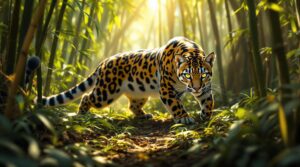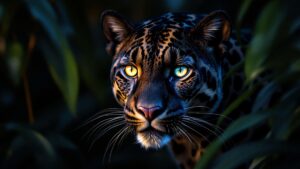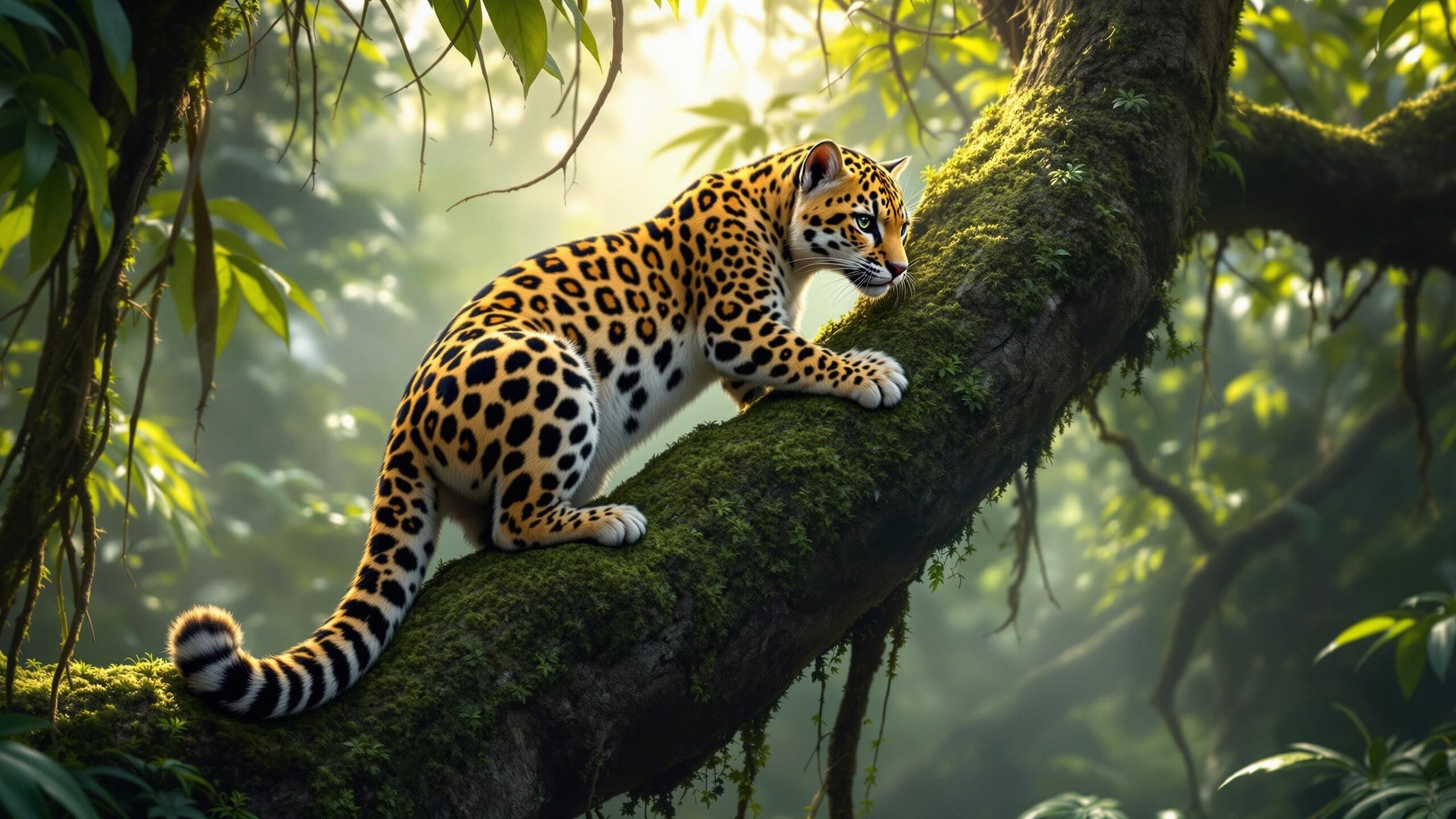Clouded Leopards: The Jungle’s Phantom Cats with the Grace of Shadows
In the emerald labyrinths of Southeast Asia’s tropical rainforests, where sunbeams dapple leaves like fragments of gold and vines weave stories into the canopy, there lives a creature so elusive it seems woven from mist itself. The clouded leopard, with its dreamlike patterning, acrobatic prowess, and secretive nature, is one of the most mysterious cats in the world. Rarely seen and seldom understood, it moves like a specter through the treetops, a silent guardian of the jungle’s ancient rhythms.
The clouded leopard (Neofelis nebulosa) is not a true leopard, nor is it closely related to the larger rosette-marked cats of Africa or the Americas. It occupies its own genus, Neofelis, and embodies a unique evolutionary lineage. With its ethereal beauty and tree-dwelling adaptations, the clouded leopard is a bridge between the big cats and the smaller felines—a living relic and a marvel of specialized survival. To know this cat is to explore an entire ecosystem through the eyes of a solitary, silent observer.

Mainland Clouded Leopard
The Mainland Clouded Leopard: Specter of the Southeast Asian Forest In the shrouded canopy of Southeast Asia’s tropical rainforests, where sunlight filters in scattered beams and silence rules beneath a cloak of greenery, there lives a cat unlike any other. Mysterious, solitary, and incredibly agile, the Mainland Clouded Leopard, scientifically known as Neofelis nebulosa, is a predator that seems conjured from mist. With its beautifully patterned coat, piercing eyes, and

Sunda Clouded Leopard
The Elusive Ghost of the Rainforest: The Sunda Clouded Leopard Deep in the ancient rainforests of Borneo and Sumatra, among the dense canopies and shadowed undergrowth, prowls one of Southeast Asia’s most mysterious predators—the Sunda clouded leopard (Neofelis diardi). A master of stealth and solitude, this rare feline is a marvel of evolution, blending feline grace with unparalleled arboreal agility. Though it shares part of its name with its cousin,
A Masterpiece of Evolution: Biology and Physical Characteristics of the Clouded Leopard
The clouded leopard stands apart from its feline cousins in almost every way. Slightly larger than a housecat but smaller than a leopard, it is considered a medium-sized wild cat. Males typically weigh between 30 and 50 pounds, while females are slightly smaller. But its modest size belies its incredible power and agility.
Its most distinctive feature is its coat—a base of golden or dusky brown overlaid with large, irregular blotches that resemble clouds, hence the name. These markings serve as perfect camouflage amid the dappled forest light and shifting foliage. Its head is short and rounded, with large, expressive eyes that hint at its nocturnal nature.
Perhaps most extraordinary are the clouded leopard’s physical adaptations for life in the trees. It possesses the longest canine teeth relative to skull size of any living feline, reminiscent of saber-toothed cats of the past. Its flexible ankles can rotate to allow it to climb down trees headfirst, and its long, bushy tail provides impeccable balance. This cat doesn’t just survive in the forest canopy—it rules it, leaping between branches and climbing with the ease of a monkey.
The Mainland Clouded Leopard: Secrets of the Southeast Asian Rainforests
The most well-known species within this category is the mainland clouded leopard (Neofelis nebulosa), found across a broad swath of South and Southeast Asia. From the dense jungles of Nepal and Bhutan to the subtropical forests of Myanmar, Thailand, Laos, and southern China, this cat remains an enigma despite its widespread range. Mainland clouded leopards are rarely seen, even in protected reserves. They are primarily nocturnal and crepuscular, resting in the treetops during the day and descending at dusk to hunt. Their diet includes arboreal prey like monkeys and birds, as well as terrestrial animals such as deer, porcupines, and pigs. Their hunting strategy is as agile as it is lethal—leaping, pouncing, and delivering a powerful bite that can pierce through thick hides and bone. Conservation efforts in these regions have been hampered by habitat destruction and illegal poaching. Their stunning pelts are highly valued in the black market, and their bones are sometimes used in traditional medicine. Logging and agriculture continue to fragment the forests they depend on. Yet in countries like Bhutan and Thailand, camera trap studies and protected corridors are helping researchers learn more about their range, behavior, and ecological importance.
The Sunda Clouded Leopard: A Separate Species in the Island Shadows
In 2006, genetic research revealed a remarkable discovery—what was once thought to be a single species of clouded leopard was actually two. The Sunda clouded leopard (Neofelis diardi) is native to the islands of Borneo and Sumatra, and is genetically distinct from its mainland cousin. This revelation marked a major milestone in cat taxonomy and underscored the need for region-specific conservation.
Sunda clouded leopards are generally smaller and darker in coloration than N. nebulosa, with finer, more narrowly spaced cloud patterns. They occupy the dense, often mountainous rainforests of their island homes and are similarly elusive. Little is known about their behavior, but studies suggest they are solitary, arboreal, and secretive, with a diet likely consisting of small deer, rodents, birds, and primates.
Deforestation from palm oil plantations, mining, and road-building poses a dire threat to the Sunda clouded leopard. With their habitats being stripped away and fragmented, these cats face increased competition, reduced prey, and higher risk of human conflict. Conservation organizations are working to establish and connect wildlife corridors, protect primary forests, and engage local communities in preservation efforts.
Clouded Leopard Cubs: Early Life in the Forest Canopy
The story of a clouded leopard begins in silence. In the hollow of a tree or a dense thicket, a mother gives birth to a litter of one to five cubs, though two is most common. The cubs are born blind and helpless, with their eyes opening after about ten days. For the first several weeks, they remain hidden, nourished by their mother’s milk and guarded from threats. Around three months of age, clouded leopard cubs begin to follow their mother on brief hunting forays. They learn to climb, leap, stalk, and strike—skills that will one day determine their survival. By six months, they begin hunting small prey independently. Around ten to twelve months of age, they disperse to claim their own territories.
In captivity, clouded leopard cubs have been notoriously difficult to breed and rear, primarily due to stress and maternal abandonment. However, improved understanding of their needs, habitat enrichment, and hand-rearing practices have led to better outcomes in recent decades. These efforts are not only crucial for captive populations but also serve as a genetic safety net for dwindling wild numbers.
Cultural Legends and Symbolic Power: The Clouded Leopard in Human Imagination
Clouded leopards, like many rare and powerful animals, have earned a place in the mythologies and folklore of the regions they inhabit. In some indigenous Bornean cultures, they are regarded as forest spirits—animals to be feared, respected, or avoided. Their ghostly appearance and ability to vanish into the trees have made them symbols of the unknown and the magical. In Chinese folklore, they are sometimes conflated with other big cats, appearing in stories as mysterious beings who live deep in the mountains . In tribal traditions of the Himalayan foothills, they may appear as animal guides or omens. Their beauty, stealth, and strength have led to both admiration and exploitation, making them both icons and targets in human society. Today, clouded leopards are increasingly embraced as ambassadors for rainforest conservation. Their charisma, combined with their endangered status, makes them powerful focal points for environmental education, wildlife tourism, and international preservation campaigns.
Ecological Role: The Invisible Architects of the Forest
Clouded leopards may be shy and seldom seen, but they play an outsized role in maintaining forest health. As apex predators in their ecosystems, they regulate prey populations and help keep trophic levels in balance. Their presence influences the behavior of herbivores like deer and wild pigs, which in turn affects vegetation and tree regeneration.
Unlike other big cats that prefer the ground, clouded leopards also impact the arboreal food web. Their predation on tree-dwelling species like monkeys and birds can affect seed dispersal patterns and insect populations. They are both predators and indicators—symbols of a functioning, thriving ecosystem.
The decline of clouded leopard populations often signals deeper ecological problems: deforestation, bushmeat hunting, and biodiversity collapse. Protecting them helps safeguard the intricate web of life in tropical rainforests, from fungi to fruit trees to hornbills.
Threats and Conservation: A Race Against Deforestation
The clouded leopard faces numerous threats, all largely linked to human activity. Habitat destruction is the most pressing. In countries like Malaysia, Indonesia, and Myanmar, forests are cleared at alarming rates for agriculture, logging, and infrastructure. These actions not only shrink clouded leopard habitat but fragment it, making it difficult for individuals to find mates, food, or secure territory. Poaching is another significant issue. Clouded leopards are killed for their luxurious pelts, decorative teeth, and bones used in traditional medicine. Even when not targeted directly, they often fall victim to snares and traps intended for other animals. The illegal pet trade has also contributed to the species’ suffering, with cubs sometimes captured and sold.
Despite these challenges, hope is not lost. Protected reserves across Southeast Asia, from Thailand’s Kaeng Krachan to Borneo’s Deramakot Forest, provide vital refuge. Camera traps, radio collars, and DNA analysis are helping researchers build a clearer picture of their range and behavior. Conservation groups are working closely with indigenous communities to promote coexistence, reduce conflict, and provide economic alternatives to deforestation.
Technological Tools and International Collaboration in Saving Clouded Leopards
One of the most exciting developments in clouded leopard conservation is the use of modern technology. Camera trap networks have become the primary method of studying these elusive cats, allowing scientists to identify individuals, estimate population density, and monitor cub survival rates. These silent observers in the forest offer rare, intimate glimpses into the hidden life of the clouded leopard.
Radio telemetry—collaring select individuals with GPS transmitters—has allowed researchers to track movement patterns, territorial range, and behavior. In places like Sabah, Malaysia, collared leopards have revealed unexpectedly large home ranges and complex habitat use, guiding land management decisions.
Additionally, international collaboration has become a cornerstone of clouded leopard preservation. The Global Clouded Leopard Working Group brings together scientists, wildlife managers, and policy-makers across the species’ range to share data, strategies, and funding. Such partnerships are vital, as the clouded leopard knows no borders—only forest.
Following the Shadows Through the Forest Canopy
The clouded leopard is more than a mysterious cat of the jungle. It is a living emblem of Southeast Asia’s biodiversity, a silent climber who threads together branches of ecological health, cultural reverence, and evolutionary wonder. Its footsteps are light, but its impact runs deep—through the prey it manages, the myths it inspires, and the forests it calls home. As climate change, deforestation, and wildlife exploitation accelerate, the clouded leopard stands as both a victim and a symbol. Its fate is intertwined with that of the rainforest, and protecting one means saving the other. Every fallen tree, every snare in the underbrush, every unchecked poacher is another shadow cast over this ghost of the trees. But there is hope—rooted in knowledge, collaboration, and passion. Conservationists, scientists, forest guardians, and local communities are weaving together a new future. A future where clouded leopards are not just ghosts but guardians, not just myths but messengers. Now is the time to learn more. Explore their habitats. Understand their differences. Follow the stories of their survival. The canopy holds many secrets, and in its shadows, the clouded leopard waits—not just to be seen, but to be understood.

